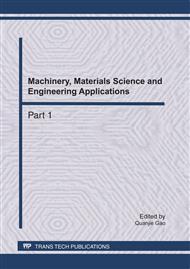p.293
p.299
p.303
p.309
p.315
p.321
p.327
p.332
p.340
Birch Carbonization Surface Micrograph and Element Analyses
Abstract:
There are close relationships between the surface micrograph and element contents of birch and its heating-up temperature. By using the scanning electron microscope (SEM) and the X-ray energy dispersive spectrometer (EDS), the surface micrograph and element contents of birch carbonizations prepared in the simulating fires with different heating-up temperatures were observed and compared. The results show that as the heating-up temperature rises, the surfaces of tracheids gradually become smoother, and the cross sections of tracheids change from circular or ovate shape to polygon. The external films of tracheid fibers are damaged and bordered pits are exposed gradually with the increasing of heating-up temperature. At high temperature, bordered pits change from flat eye-like pores to circular pits, at the same time, the carbon content increases from 52.46% to 90.96%, and the oxygen content decreases from 47.34% to 8.31%, while the potassium and calcium content increase. Thus, the study of connecting wood surface micrographs and element contents with heating-up temperature is useful in fire trace and evidence identification, and the result is meaningful to fire investigation.
Info:
Periodical:
Pages:
315-320
Citation:
Online since:
April 2011
Authors:
Keywords:
Price:
Сopyright:
© 2011 Trans Tech Publications Ltd. All Rights Reserved
Share:
Citation:


